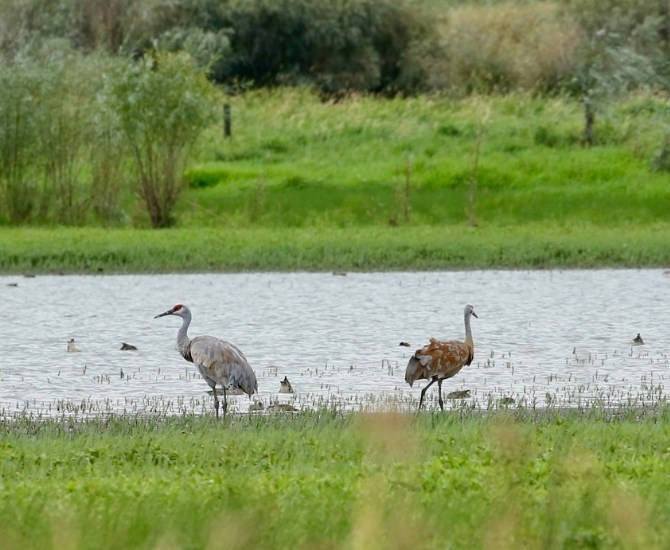
Herons at the Tranquille wetlands.
Image Credit: Kamloops Naturalist Club / Press release
April 14, 2024 - 3:30 PM
The Thompson-Okanagan region is host to many migratory bird species that stop on their way to their final destinations. As the region rapidly develops, a wildlife expert says it's important to protect the routes that are at risk of development.
The region has some of the fastest growing cities in Canada and that development puts wetlands at risk, but with proper policies they can be protected so the species that depend on them are also protected. Water birds travel through the region as they migrate during springtime and can easily come in conflict with humans.
"The majority of birds stick to lower elevation routes in the spring which is a problem because that's where people are too," Bruce Harrison, habitat biologist for Ducks Unlimited Canada, says. "In migration, a lot of what they're doing is picking up food along the way, so it's really critical that the places where they stop to rest are also places where they can forage and take on nutrients."
Harrison says the wetlands most at risk are smaller ones at lower elevations that provide good habitat in the spring.
"They are the first ones to lose their ice and to warm up and to develop invertebrate and plant communities that birds can feed on, but they're also the ones that are more at risk of coming in contact with humans and development," he says.
READ MORE: Why protecting what's left of wetlands in Kamloops, Okanagan matters
Communities that are rapidly growing can be of hindrance to wetlands, especially if they are drained. The disappearance of wetlands could then have consequences on migratory species that rely on them.
"If a wetland is drained, you have to transfer from an aquatic environment to a terrestrial environment and the communities change which we think of as a negative thing because it's less habitat for the critters that are out there," Harrison says. "As the landscape becomes drier and drier, there's more and more concentration of birds in areas that still have those resources birds need and the effects are not good and mother nature loses."
Understanding the effects of the rapid development of cities remains a challenge.
"There's definitely a risk that communities that are rapidly developing... could have an impact on these environments, but whether that's wetland loss or something else, it's hard to say," Harrison says. "We also don't track our birds too well during migration, because it's quite hard to do, so it's hard to tell the exact impact of development on these birds."
READ MORE: Vernon home to another lost Okanagan wetland
Protecting migration routes is also a complicated thing to do because it involves every level of government and while BC is doing OK, a key piece is missing, a wetland protection policy.
"Really though, there's no one government that has responsibility for everything, it's more of a combined effort," he says.
He says the City of Kelowna has guidelines in place that seem to be useful in the protection of wetlands, while no one from the city was available to comment, the Wetland Habitat Management Strategy does have a set of guidelines that prohibit certain things such as the drainage of wetlands, any sort of water pumping from wetlands, the construction within buffer zones meant to protect the environment, and more.
The Regional District of Central Okanagan also considers migration stop-over points in their permit process to ensure the protection of environmentally sensitive areas.
The provincial and federal governments also have a set of guidelines and laws in place created to ensure the protection of these migratory routes and migratory species.
Harrison says it's difficult to say whether or not the guidelines are enough.
"There's a risk that rapid development from some of the cities might be impacting wetlands but we don't have the ability to track that very well. Ideally, they have municipal bylaws that prevent wetlands from being obliterated when they develop them, but there are probably some impacts regardless."
To contact a reporter for this story, email Gabrielle Adams or call (438) 830-1211 or email the editor. You can also submit photos, videos or news tips to the newsroom and be entered to win a monthly prize draw.
We welcome your comments and opinions on our stories but play nice. We won't censor or delete comments unless they contain off-topic statements or links, unnecessary vulgarity, false facts, spam or obviously fake profiles. If you have any concerns about what you see in comments, email the editor in the link above. SUBSCRIBE to our awesome newsletter here.
News from © iNFOnews, 2024